How can I make Emacs show blank spaces (like a space, a tab, a line-jump, etc). Many other editors like Kate and Eclipse have this feature and I find it very useful to see when code is indent-broken because of mix of spaces and tabs (particularly Python).
3 Answers
WhiteSpace mode is an Emacs minor mode for visualizing all white space characters in the current buffer. It can be activated with M-x whitespace-mode.
Here is a screenshot of WhiteSpace in action taken directly from the Emacs wiki,
Note: WhiteSpaceMode has now replaced BlankMode
- 1
- 1
- 14,062
- 17
- 82
- 103
-
23Thanks for the screenshot and the link, but you forgot to actually tell us how to turn that feature on. (It's `M-x whitespace-mode` btw.) – bug Aug 15 '13 at 15:54
All the possible settings to do that seem to be summarized here (blank-mode) and here and here (ShowWhiteSpace)
also:
(if (>= emacs-major-version 22)
(progn
;; Mode to use with Emacs 22
;; http://emacswiki.org/cgi-bin/wiki/BlankMode
(require 'blank-mode)
;; Mode not active by default: let's activate it
(global-blank-mode t)
;; ... activate it when text mode where color syntax is not active by default
(add-hook 'text-mode-hook 'blank-mode-on)
;; All invisible chars are shown, except newline char.
(setq blank-chars '(tabs spaces trailing lines space-before-tab))
;; Show only for one color, no mark inserted
(setq blank-style '(color))
;; Use for normal space (not shown)
(set-face-background 'blank-space-face nil)
(set-face-foreground 'blank-space-face "black")
;; used for non breakable space
(set-face-background 'blank-hspace-face "PaleGreen")
(set-face-foreground 'blank-hspace-face "black")
;; Used for spaces left of a tab
(set-face-background 'blank-space-before-tab-face "orange")
(set-face-foreground 'blank-space-before-tab-face "black")
;; Used for tab
(set-face-background 'blank-tab-face "lemonchiffon")
(set-face-foreground 'blank-tab-face "black")
;; used for extra space at the end of a line
(set-face-background 'blank-trailing-face "gold")
(set-face-foreground 'blank-trailing-face "black")
;; Used for line too long
(set-face-background 'blank-line-face "snow2")
(set-face-foreground 'blank-line-face "black")
)
(progn
;; For older Emacs prior to version 22.
;; http://www.emacswiki.org/cgi-bin/wiki/show-wspace.el
(require 'show-wspace)
(add-hook 'font-lock-mode-hook 'show-ws-highlight-tabs)
(add-hook 'font-lock-mode-hook 'show-ws-highlight-hard-spaces)
(add-hook 'font-lock-mode-hook 'show-ws-highlight-trailing-whitespace)
)
)
indent-broken? - never use tabs in your code - disk space is cheap these days.
Put (setq-default indent-tabs-mode nil) in your .emacs file. Get used to typing C-x h M-x untabify to untabify the entire buffer. To search for tabs type C-s C-i. If you have obscure control characters in your buffers you can see them with M-x hexl-mode.
Also C-x h M-x indent-region will indent the entire buffer. Some modes like vhdl-mode have a beautify region command.
- 257
- 2
- 4
-
10Different developers on my team have different preferences for tabwidth. Setting everything to spaces screws up the rest of the team. Thanks for playing, though. – warfangle Aug 27 '10 at 16:03
-
Just for the record: it should be `C-h f untabify` instead of `C-x h M-x untabify` – To1ne Feb 07 '11 at 21:04
-
2Emacs is good for other kinds of files (like, say, tab-delimited data files), not just code! Neat, huh? – Anne Aug 09 '11 at 15:59
-
3@To1ne `C-h f untabify`: help about `untabify`. `C-x h M-x untabify`: mark the buffer, then run `untabify`. – Jerome Baum Jan 19 '12 at 17:18
